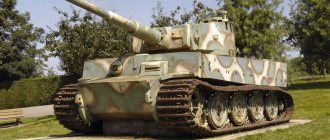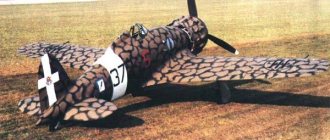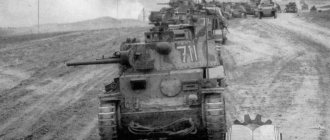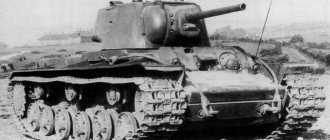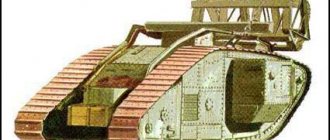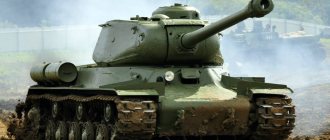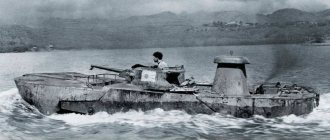History of Italian tank building
Italy entered World War I on May 23, 1915, declaring war on Austria-Hungary. At the initial stage on the Italian front, the Italian army managed to capture some enemy territories, but the offensive fervor of the Italians quickly dried up, and in 1916 the troops of Austria-Hungary went on the offensive, inflicting a number of heavy defeats on the Italians. Only thanks to the help of the allies did the Italians manage to stop the advance of the Austro-Hungarian troops and stabilize the front. On the Italian, as well as on the Western Front, the war took on a protracted positional character.
Tank of Italy "Fiat" 2000
In search of a way out of the positional impasse, the Italian command came to the conclusion that it was necessary to provide the troops with such a new type of weapon as a tank.
Back in 1915, a prototype of a heavy two-turret tank with machine gun armament was presented by Italian Army captain Luigi Cassali. However, the mountainous conditions of the Italian front did not allow the Cassali vehicle to be used effectively, and it was declared unsuitable for the army.
However, the crisis of trench warfare at the front forced the high command to reconsider its views. However, instead of creating their own tanks, they decided to purchase tanks abroad, in particular in France. This decision of the Italian high command seems strange, because as of 1915, engineering personnel and the military-industrial complex were ready to create their own tank. Back in 1910, the first armored vehicles of its own production appeared in the Italian Royal Army. Moreover, the Italians were the first to use them, using Bianchi armored vehicles in combat against Turkey in Tripoli in 1913.
But France, which was in a difficult situation, managed to deliver only one SA-1 Schneider tank and three Renault FT-17 tanks until the end of the war.
Despite the fact that the Supreme Command of the Royal Army decided to purchase tanks from France, in 1916 the designers began creating their own tank. It was assumed that if the military did not pay attention to the development, a heavy tractor for civilian use would be created on its basis.
The new Italian tank, called the Fiat 2000, implemented the concept of a mobile fort, which puts it on par with tanks such as the SA-1 Schneider, Saint-Chamon, A7U and English diamond-shaped tanks. However, the Fiat 2000 was superior in combat qualities to its French and German counterparts and could even compete with the English ones.
But the Italian military, although they appreciated the tank, continued to rely on French supplies. Only after the arrival of the French SA-1 Schneider tank and its comprehensive testing, which showed the low combat suitability of the French vehicle, did the military seriously pay attention to developments. Thus, only in February 1918 did it begin serial production of its tanks.
The Fiat 2000 was built according to a three-tier scheme, characteristic of the German analogue of the A7U. The engine-transmission compartment occupied the first (lower) tier. On the second was the place of the tank commander, who simultaneously acted as the driver, on the third was the fighting compartment with workplaces for the shooter, loader and seven machine gunners. The crew's protection was provided by a steel frame on which sheets of rolled armor steel 1520 mm thick were attached.
Experts achieved excellent firing characteristics of the vehicle by installing 6.5-mm Fiat-Revelli machine guns of the 1914 model, which virtually did not leave any “dead zones,” and a Canon 65/17 gun of the 1913 model in the squat turret on the roof housings. Thanks to the rotating turret, the gun could perform a wide range of tasks - from clearing trenches to hitting targets hidden behind an obstacle, since it had the possibility of vertical guidance ranging from 10 to 75 °. The fire was carried out with high-explosive shells weighing 4.3 kg with an initial speed of 345 m/s and a maximum firing range of up to 6800 m.
Memorial in the Alps to Italian soldiers killed in the First World War
Among the successful solutions of Italian designers was the installation of a mirror periscope device, with the help of which the commander could observe the battlefield, hiding behind an armor plate. This distinguishes the tank from its analogues, where observation was carried out through open slits, which often led to damage to the eyes and face.
The tank has a combat weight of 42 tons, equipped with an aviation six-cylinder gasoline engine "Fiat" A-12 with a power of 240 hp. s., developed a speed of 7 km/h. During tests, Italian tanks showed good dynamic qualities and maneuverability even in difficult mountainous conditions. Thus, the Fiat 2000 overcame a ditch up to 3.5 m wide, a vertical hill up to 1.1 m high, a water barrier up to 1 m deep, and could break through a brick wall or knock down a tree.
More than a hundred of these tanks were planned to be built, but only four were produced as World War I ended.
During the operation of the Fiat 2000 tanks, a number of significant shortcomings were revealed, most of which were characteristic of other similar tanks. Thus, the work of the crew was complicated by severe shaking, high temperatures and the accumulation of powder gases after shots from a cannon and machine guns. After only 4 hours of operation, the engine overheated greatly and there was a risk of fire, which was especially risky considering that only one door was provided for evacuation. The center of gravity of the tank was too high, which made it unsafe to use the tank in the mountainous terrain along which most of Italy's continental borders passed.
The lack of basic means of communication on the tank also caused criticism; because of this, in conditions of strong shaking and noise created by the working engine, crew members had to communicate with each other using gestures. There was no communication with other tanks at all. The Fiat 2000 stood out for its huge fuel consumption - about 800 liters per 75 km.
Despite this, the tank, which never had time to take part in the fighting of the First World War, was sent to Tripolitania (the northwestern territory of modern Libya). It is not known for certain whether the Fiat 2000 participated in military clashes with the rebel Arab tribes or was used only as intimidation.
In the early 1930s. These tanks were considered hopelessly outdated, however, the command of the Royal Army ordered their modernization, replacing the machine guns located in the two front corners with 37-mm cannons. Only in 1934 were the completely worn-out Fiat 2000 tanks removed from service.
It should be noted that by the beginning of World War II, Italian tank divisions relied mainly on infantry formations. It cannot be said that the tank divisions of the Italian army were organized ideally: throughout the war, the problem of operational-tactical control remained unresolved. In order to coordinate the actions of armored formations, a radio station alone was not enough, so the use of more flexible and sophisticated tactics was difficult. Unfortunately, the Italian army could not boast of adding new models.
Light tank "Fiat" 3000
In 1918, three French-made Renault FT-17 tanks entered service with the Italian Royal Army. The Italian military highly appreciated the capabilities of this vehicle and expressed a desire to purchase more. However, during the First World War, French industry had difficulty providing its own army with tanks and was unable to supply the required number of Renault FT-17s to the Italian army.
Thanks to the careful sealing of the body, the Fiat 3000 could overcome water obstacles up to 1.5 m deep
Then in Italy they decided to produce a similar tank on their own. Breda was also commissioned to develop a new tank for the Italian army. Production was scheduled to begin on .
The first prototype of the tank, designated Fiat 3000 model 21 (Fiat 3000A), appeared in 1920. The Fiat 3000A tank entered mass production in 1923 and was adopted by the Italian army. The Fiat 3000A differed from its prototype, the French Renault FT-17 tank, by a significantly higher speed (up to 21 km/h compared to 7.8 km/h). This was achieved thanks to lower weight (5.5 tons) and a four-cylinder liquid-cooled carburetor engine with a power of 63 hp. With. The tank was armed with two twin 6.5-mm Fiat machine guns with 2,000 rounds of ammunition. Beginning in 1930, Fiat 3000A tanks began to be equipped with 8-mm Fiat 35 machine guns with 3,440 rounds of ammunition.
French Renault FT-17 tank, on the basis of which the Fiat 3000 tank was created
In 1929, a new modification of the Fiat 3000B tank appeared, in which 37-mm cannons were installed instead of machine guns.
A total of 152 tanks of the Fiat 3000A and Fiat 3000B modifications were produced. Modifications with a 105 mm howitzer and twin 37 mm guns were also developed, but none of them entered mass production.
Service and combat use
The combat debut of the Fiat 3000 tanks took place in the Second Italo-Ethiopian War (1935-1936). The Ethiopian army, large but poorly equipped (many warriors were armed with spears and bows), Fiat 3000 tanks inflicted serious damage, while remaining practically invulnerable. But even in such favorable conditions for the Italians, several tanks were lost, and several were captured by Ethiopian troops.
Successes in Ethiopia and an overestimation of his own capabilities pushed Benito Mussolini to aggression against Greece, where Fiat 3000 tanks fought alongside new vehicles. During this armed conflict, the hopelessly outdated Fiat 3000 tanks (as well as the entire Italian army as a whole) were not succeeded; as a result, these vehicles did not participate in battles for several years.
The Fiat 3000 tanks were remembered again in the summer of 1943, when tanks buried in the ground were used as stationary firing points in combat operations with the Anglo-American landing force.
Post-war time
Italy was prohibited from producing tanks after World War II. This also applied to any other heavy weapons. The country's tank forces were equipped with American armored vehicles. The situation changed after the 1970s. Since that time, new Italian tanks have been created on the basis of the German Leopard 1A4. This model served as the basis for the main Italian tank F-40. Military equipment was produced in small quantities and exclusively for sales to other countries. In the 1990s, Italian tank forces were equipped with self-made S-1 Ariete combat vehicles. This model is considered a third generation tank and, according to experts, the most expensive in the world.
Light tank L6/40
In the Second Italo-Ethiopian War (1935-1936), the Italian wedge "Caro" CV3/33 (according to the Italian classification - a light tank) proved to be excellent in clashes with poorly armed North African tribes, but was completely ineffective even in clashes with lightly armored vehicles. This convinced the Italian military leadership of the need to create a light tank that could not only conduct reconnaissance and fight lightly armed enemies, but also fight armored vehicles and light tanks.
Italian wedge heel "Caro" CV3/33
The development of such a tank was also entrusted to Ansaldo, which already had experience in creating light tanks for export.
A new light tank for the Italian army, designated L6/40, was developed in 1936-1938. based on the five-ton export version of the Fiat Ansaldo tank. Since 1940, the machine went into mass production. The L6/40 had a layout typical for most light tanks of the pre-war period, with the propulsion system located in the rear of the hull, the transmission and drive wheels in the front, and the fighting compartment and control compartment in the middle.
The hull and multifaceted turret are made of rolled armor plates located vertically or at a slight angle to the vertical. The thickness of the frontal armor is 30 mm, the side armor is 15 mm, and the turret armor is 40 mm.
The tank was armed with a 37-mm cannon and a coaxial 8-mm Breda 38 machine gun. The ammunition included 312 rounds and 1,560 rounds of ammunition.
Four-cylinder carburetor liquid-cooled engine with a power of 70 hp. With. allowed the tank to reach speeds of up to 42 km/h.
Flamethrower tank L6/40 LF
Based on the L6/40, they developed the L6/40 LF modification, which instead of a cannon was equipped with a Fiat OCI flamethrower, an Italian anti-tank self-propelled gun with a 47-mm Semoventede 47/32 cannon, as well as Singoletta L40 and Caro ammunition transporters - "Portamunizioni" L40.
A total of 682 L6/40 tanks, about 400 Semovente de 47/32 self-propelled guns and a small number of L6/40 LF flamethrower tanks were produced.
Service and combat use
The L6/40 tank entered combat units only in the spring and summer of 1942. It was planned that it would replace the CV3/33 wedge, but was actually used in parallel with it.
The L6/40 tanks and the Semovente de 47/32 self-propelled guns created on their basis were not liked by the military, as they were already considered obsolete compared to tanks from other countries and could only be used as reconnaissance or patrol vehicles. However, the tasks of the L6/40 light tanks also included assaulting well-fortified positions with anti-tank weapons. Claims were also made against the self-propelled gun "Semovente de" 47/32, which was open at the top, for which it was nicknamed a self-propelled coffin.
However, the tank was actively used on all fronts with the participation of Italian troops, where it proved to be a reliable, but practically defenseless vehicle against modern types of anti-tank weapons. The hardest thing was for the crews of tanks and self-propelled guns who fought as part of the Italian expeditionary corps on the Eastern Front. The corps, transferred to the command of the 1st Panzer Group of the German General Ewald von Kleist (since October 25, 1941, it was reorganized into the 1st Panzer Army), even achieved some successes at the initial stage of the campaign, making a significant contribution to the assault on the city of Stalino (modern Donetsk). However, at Stalingrad, Italian troops had to face not only fierce resistance from Soviet troops, but also severe frosts, for which Italian tanks were not prepared. As a result, most of the corps' tanks were lost without causing significant damage to the enemy.
After the surrender of Italy, the remaining L6/40 tanks and self-propelled guns based on them were adopted by the Wehrmacht under the designation PzKpfw L6(i) and StuG L6 mit 47/32 770(i), respectively. Moreover, according to the German order in 1943-1944. additionally produced 51 tanks and 120 self-propelled guns.
A number of L6/40s captured from Italian troops were used by Yugoslav partisans, Croatian Ustashas to whom they were transferred by Germany, and Soviet troops who captured tanks at Stalingrad.
The L6/40 tank is the heaviest vehicle that the Italian army sent to the front. In addition, a flamethrower tank was developed based on the L6/40. It weighed 200 kg more than the base model, but it was never accepted for service.
Medium tanks of Italy class M
In the 1930s The Italian military leadership chose a course for the development of aviation and navy. The qualitative and quantitative indicators of the armored forces were considered satisfactory, since the northern land border of Italy mainly runs along the ridges of the Alps, a region unfavorable for the use of tanks, and in North Africa the Italian army had to deal only with poorly armed African tribes.
Tank M 13/40 in the desert of Libya
However, there was experience in the Spanish Civil War, in which the Italian army, which supported General Francisco Franco, had to face the armored forces of other countries, which were significantly superior in performance to Italian equipment. It was necessary to change the system of Italian armored forces, which were to be armed with three types of tanks: light - with a combat weight of 5-6 tons, armed with a 13.2 mm machine gun (denoted by the letter L); medium - with a combat weight of 7-10 tons, armed with an automatic cannon of up to 20 mm caliber (designated by the letter M); heavy - with a combat weight of more than 11 tons, armed with a cannon of up to 47 mm caliber (denoted by the letter P).
The M-class tank was developed on the basis of a British light tank of the 1930s. "Vickers" Mk E ("Vickers-six-ton"). In 1939, the car was put into mass production.
Unlike the English prototype, the Italian tank, designated M11/39, was already considered obsolete at the time of production. Thus, weak armor and armament, which required modifications to the tank engine and transmission, combined with unsuccessful design solutions (for example, the main 37-mm Vickers-Terni L40 gun was located in the hull superstructure and had a very limited aiming angle, as a result, for aiming at the target the entire tank had to be turned around) did not allow the M11/39 to compete with tanks from other countries. However, in 1940, M11/39 tanks were sent to North Africa, where they clashed with British tanks. As a result, it became obvious that the Italian tank was lagging behind the British in almost all respects - and the serial production of Italian tanks was stopped.
The unsuccessful design of the M11/39 required a radical redesign, so in 1940 it introduced a new M-class tank, designated M13/40. Unlike its predecessor, it received more powerful armor, a 47-mm 47/32 type gun with a coaxial 8-mm Breda machine gun in the turret, and a power plant whose power was increased to 125 hp. With. However, when compared with the previous model, the M13/40 still had a number of significant shortcomings. In particular, the extremely weak chassis has not been modernized. The thickness of the frontal armor of the turret, although increased to 40 mm, remained almost straight, without a rational slope of the armor plates. The tank still had many vulnerable spots (for example, the hatch for the crew to enter and exit).
Italy did not have a better car at that time, and the M13/40 tank was put into mass production. It became the most produced Italian tank of World War II. A total of 799 of these combat vehicles were produced.
According to the Italian classification, class M vehicles are classified as medium tanks, but if we take into account the mass and armament of the tank, they should be classified as light. In the photo - Italian tank M13/40
In an attempt to improve the armament of the Italian armored forces, in 1941 they began production of a new M-class tank, designated M14/41. But, like its predecessors, already at the time of production it was considered obsolete. The M14/41 differed from its predecessor in improved armor and weapons, which, however, were considered extremely weak compared to tanks from other countries.
The last tank of this series - M15/42 - was developed in 1942. Its production began in January 1943. The M15/42 tank was equipped with a new SPA 15TB liquid-cooled carburetor engine with a power of 185 hp. pp., thanks to which it was possible to significantly increase the mobility of the machine. However, due to the increased fuel consumption of the new engine, the fuel tanks had to be almost doubled.
The tank was armed with a 47-mm 47/40 type gun and four 8-mm Breda machine guns. Thanks to the increased length of the gun (40 calibers compared to 32 calibers of previous versions), the M15/42 was distinguished by increased armor penetration, if we take into account the earlier M-class tanks. However, the 47/40 type gun, as before, was completely ineffective against the well-armored British and American tanks. The main gun of the M15/42 tank was installed in a turret, which could rotate 360° using an electrical mechanism. Two coaxial machine guns were placed in a ball mount in a small wheelhouse in the front part of the hull, another such machine gun was coaxial with a cannon, and the last machine gun, mounted on the roof of the turret, could be used as an anti-aircraft gun.
Service and combat use
North Africa became the main theater of operations for M-class tanks. In 1939, 24 M11/39 tanks were delivered to Italian East Africa. Lack of adaptation to local conditions, combined with poor crew training and lack of spare parts, led to the rapid failure of these vehicles.
In July 1940, the number of combat-ready M11/39 tanks in North Africa was increased to 70 units, and in the coming months the Italian armored forces managed to achieve some successes. However, already in the winter of 1940-1941. they encountered British Matilda tanks, whose armor was not penetrated by the 37 mm M11/39 cannons. During the clashes, the British destroyed Italian tanks one after another, while remaining virtually invulnerable. The situation did not change after January 17, 1940, when M13/40 and later M14/41 tanks arrived in North Africa.
The main problem of M-class tanks in North Africa is their use for performing tasks beyond their capabilities, such as storming fortified positions with anti-tank weapons or attacking British and American tanks that were superior in characteristics.
MARKING OF SANITARY TRANSPORT
This marking was fully consistent with the designation system for ambulance transport vehicles in other countries: a large red cross on the roof of the vehicle and rear doors and a white circle (about 23 cm in diameter) with a red cross on the sides of the vehicle. In North Africa, the Lancia 3R0 ambulance had a large white cross on the sides and rear of the body. If the car was not an ambulance, then these crosses could be mistaken for airborne identification marks. There are no other examples of the use of white crosses on ambulances.
Heavy tank P26/40
The first clashes between Italian tanks I and British in North Africa, in which Italian vehicles were destroyed in the hundreds, causing virtually no damage to British armored forces, clearly showed the urgent need to put into service a fundamentally new tank capable of resisting Allied tanks.
The Caro Armato P26/40 was considered a heavy tank in Italy. But with a combat weight of 26 tons, it should be classified as a medium tank
The development of a new heavy tank for the Italian army was also entrusted to Ansaldo, who already had extensive experience in the development of light and medium tanks. However, they had not yet created heavy tanks, so work proceeded extremely slowly. The first two prototypes were ready for field testing only at the beginning of 1942. During testing, many disagreements arose between the Italian military command and Fiat engineers, the main one being the choice of engine.
An accident intervened in the course of further work on the tank. At the end of 1942, a captured T-34 tank was delivered to Italy, a detailed study of which showed that the P26/40 can be considered obsolete even before entering production. Both its design and armament required a radical revision.
As a result, in the spring and summer of 1943, the military was presented with three more tank prototypes with improved projectile resistance and armament. They used some design solutions borrowed from the Soviet tank. In particular, the engine was copied from the Soviet engine installed on the T-34. At this stage, the decision seemed successful, but later it delayed the tank's entry into production. For a long time, Italian manufacturers could not organize the production of a copy of the Soviet engine, designated V-12 SPA.
Service and combat use
By the time the Allies concluded an armistice with Italy, not a single production P26/40 tank was ready. The German troops that occupied the country managed to capture five prototypes of this tank, as well as components for its assembly. Using these components, the Italian industry was able to assemble about 100 tanks, both of the original design and with modifications proposed by the German side. In particular, a number of cars were equipped with a Maybach HL 120 TRM gasoline engine instead of a V-12 SPA diesel engine. This replacement was dictated not so much by the desire to increase the mobility of the tank, but by the ever-increasing shortage of diesel fuel in Italy. At the same time, about 22 tanks were assembled without engines at all and were subsequently used as stationary firing points.
American forces land on the Anzio beachhead. In the foreground are two M4 Sherman tanks, against which the PzKpfw P40 737(i) tanks were to fight in battle.
However, neither the modernization nor the good armor of the P26/40 influenced the decision not to use the Italian combat vehicle against Allied tanks. The P26/40, adopted by the Wehrmacht under the designation PzKpfw P40 737(i), was used mainly in secondary areas, namely to fight the partisan movement in Northern Italy and the Yugoslav People's Army in the Balkans.
One of the few clashes between PzKpfw P40 737(i) tanks and the main Allied forces occurred during a counterattack by German troops on the bridgehead at Anzio captured by the Anglo-American landing force. But, as expected, Italian heavy tanks were unable to suppress the resistance of American anti-tank guns and retreated with losses.
REGIMENTAL INDICATORS
Cockades on the headdresses of Royal Army regiments were officially adopted as tactical insignia in the cavalry, as well as in several armored and infantry regiments, but there is only one known example of such an identification mark (similar to cockades) on the tanks of the Lancieri di Novarra cavalry regiment. , which fought under the operational command of the 133rd Armored Division "Littorio" in North Africa. The identification mark was applied to the right side of the hull of all tanks and armored vehicles included in the 3rd (armored) group of this regiment.

